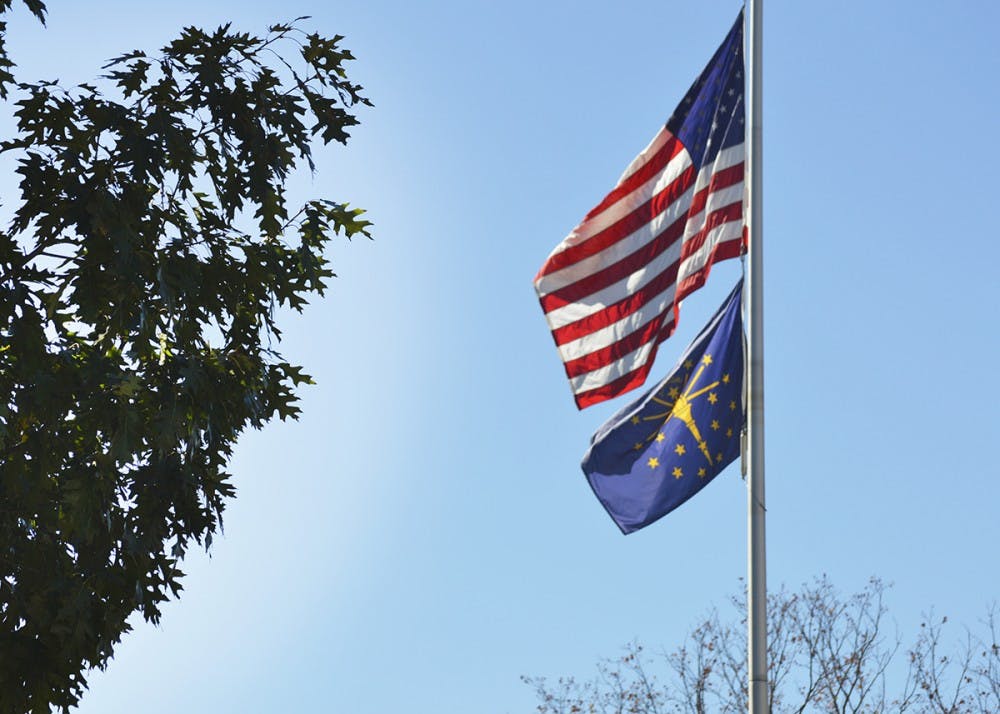Societies have been lowering flags to half-staff since 1612, when the Union Jack was reportedly lowered to honor English General John Hall, who was killed by vengeful Inuits on his expedition to Greenland.
Though the United States did not create this tradition, the influence of the symbol struck a chord with the nation and has remained a firm part of memorializing lives and important events.
According to British legend, the flag is lowered to make room to fly the flag of death above it.
Regulations on flying the flag at half-staff did not exist until 1954, when President Eisenhower put them in place. These regulations include flying flags on all federal properties, including foreign territories, of the United States at half-staff for 30 days after the death of a president.
IU’s campus is not technically bound by these regulations, but they are followed nonetheless.
Deaths of other important federal office-holders spur a shorter span of the half-staff phase, with higher offices lasting ten days and others lasting two days.
“The flag should be briskly run up to the top of the staff before being lowered slowly to the half-staff position,” according to official instructions from the Department of Veterans Affairs (DVA).
The lowering is not ceremonious.
At IU, flags are lowered when federal or local orders are given to do so. Custodial staff are in charge of lowering the flags, Gregory Fitcher, Assistant Director of Building Services, said.
“I coordinate with the various IU campuses by sending out flag requests on behalf of the Indiana Governor's office,” Jacob Benson, IU Building Coordinator said.
The network of people responsible for communicating the status of the flag is large, but Indiana Gov. Eric Holcomb has the final say on what position the flag belongs in. This logic holds unless the president's office issues a national mandate to lower the flag.
The IU ROTC program is only involved in flag movement for occasions like Veterans Day and Memorial Day. They are also responsible for carrying the flag during some football games.
IU ROTC Major Oliver Highley said Old Glory would likely also fly at half-mast if an IU-specific tragedy were to occur, such as the death of a student or faculty member.
“I’m sure they can make their own call here — if the president made the call to lower the flag accordingly,” he said.
According to the DVA, the flag is flown at half-staff when the whole nation is in mourning. This decision can be made by the president on behalf of the whole nation, or by local authorities on behalf of their localities.
The flag was flown at half-staff from Oct. 2 to Oct. 6 following the recent Las Vegas tragedy. The last time the flag was flown for an individual's death and not a collective memorial or holiday was on April 6 in memory of astronaut John Glenn, according to the Presidential Proclamations of 2017.
Flags aren’t only lowered for U.S. government related tragedies, though. In recent history, federal flags have also been lowered for the victims of the Virginia Tech and Newtown shootings, and the deaths of President of Egypt Anwar Sadat and President of South Africa Nelson Mandela.
When President Eisenhower made his official decree in 1954, the U.S. Senate confirmed that the president has the right to lower it whenever he sees fit, whether that be for the death of a foreign official or a foreign tragedy.
“The American flag doesn't give her glory on a peaceful, calm day," poet Anthony Liccione once wrote of the flag. "It's when the winds pick up and become boisterous, do we see her strength."




